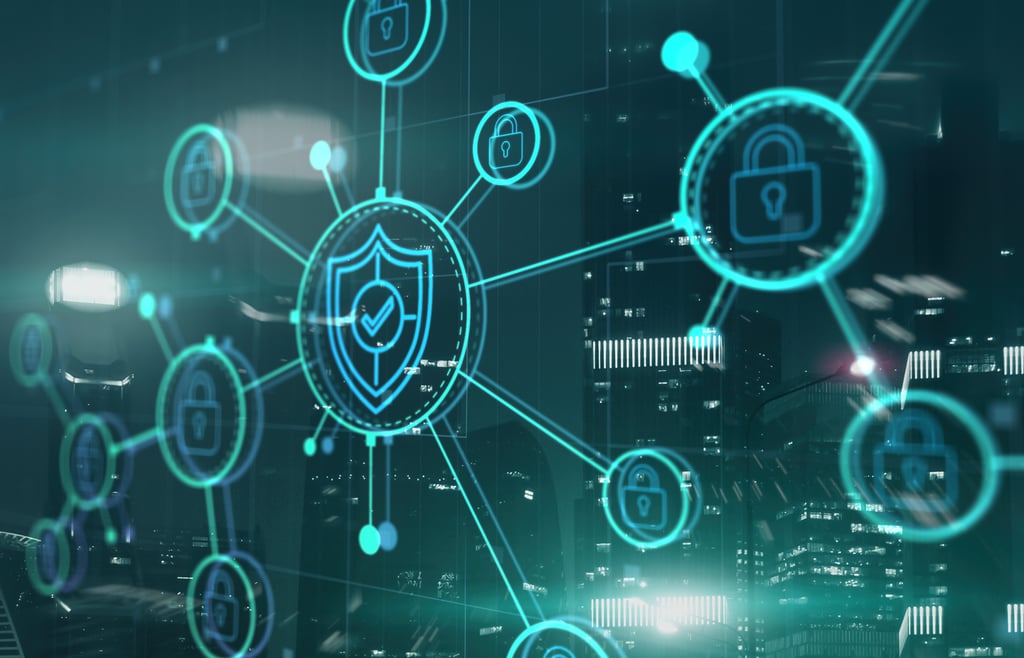
Image: Vladimir/Adobe Stock
Compare the best network security software and tools to find a solution that suits your organization’s needs best to help identify attacks and unusual events.
Network security solutions comprise software tools that protect computer networks from unauthorized access, cyber attacks, and data breaches. These solutions safeguard sensitive information, uphold data integrity, and maintain private communications within an organization.
The following are our picks for the best network security software:
The table below shows an overview of what each network security software offers beyond firewall, web security, and malware protection. It presents data on network monitoring and visibility, built-in data loss prevention (DLP), resource consumption, and impact on speed:
| Network Security Software | Network monitoring and visibility | Built-in data loss prevention | Resource consumption | Impact on speed | Starting price |
|---|---|---|---|---|---|
| BitDefender GravityZone | Comprehensive | Yes | Resource-intensive | Low | $20.99/yr per device |
| ESET Protect Platform | Comprehensive | No | Low resource utilization | Moderate | Contact sales |
| TitanHQ | Good | Yes | Minimal resource utilization | Low | Contact sales |
| Malwarebytes | Comprehensive | No | Resource-intensive | Moderate | $69/yr per endpoint |
| Kaspersky | Comprehensive | Yes | Resource-intensive | Moderate | $202.50/yr for 5 users ($40.50/user) |
| Avast Business | Advanced | No | Resource-intensive | Moderate | $29.67/yr per device |
| Sophos | Comprehensive | Yes | Resource-intensive | Moderate | Contact sales |
| Trend Micro | Comprehensive | Yes | Resource-intensive | Moderate | See cost calculator |
| SolarWinds | Comprehensive | Yes | Resource-intensive | Moderate | Contact sales; perpetual license available |
| Perimeter 81 | Good | No | Minimal resource utilization | Moderate | $8/mo. per user ($96/yr) |
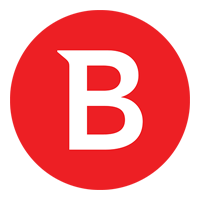
Best price and best for web security
BitDefender’s GravityZone is a comprehensive cybersecurity platform you can deploy on-premises or have hosted by BitDefender. You can also opt for a combination of both. The platform offers risk assessment and mitigation to help businesses understand cybersecurity risks. It comes with Extended Detection and Response (XDR) to provide enhanced threat detection and visibility.
GravityZone responds to security incidents automatically and guides you for fast containment of attacks. Additionally, it includes advanced capabilities, such as hardening and risk analytics, anti-ransomware, application control, exploit defense, fileless attack defense, and machine learning (ML) technology to detect sophisticated threats.
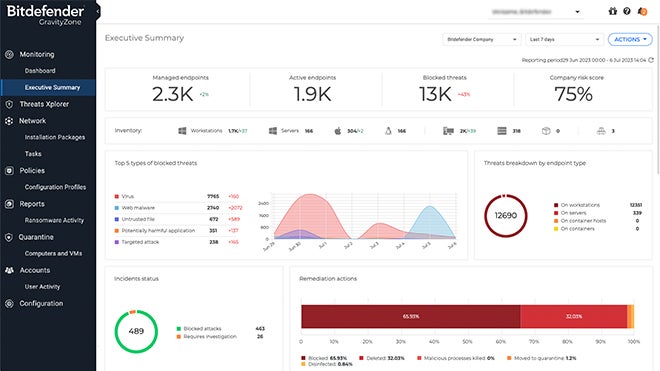
| Pros | Cons |
|---|---|
| Integrated risk analytics that constantly scansendpoints. | Limited support for macOS systems. |
| Anomaly detection and exploit defense block threats earlier in the attack chain. | Admin console is not user-friendly. |
| Identifies user behaviors that pose a security risk. | No built-in security information and event management (SIEM). |
BitDefender has different pricing options for small businesses and medium to large enterprises, as well as MSPs:
Small businesses
Medium and large businesses
Contact their sales team to learn more.
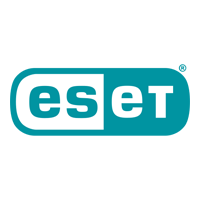
Best for network attack protection
ESET PROTECT Platform delivers real-time visibility for on-premise and off-premise endpoints as well as full reporting. It brings a range of features, including ransomware prevention, zero-day threats detection, botnet protection, and automatic updates.
The platform also has access controls and permissions, activity monitoring and tracking, alerts and notifications, anomaly and malware detection, and anti-spam features.
ESET’s solutions are designed to be lightweight and have minimal impact on system performance, making them suitable for various IT environments. The ESET PROTECT Platform allows businesses to shield their networks and data, ensure business continuity, and comply with regulations.
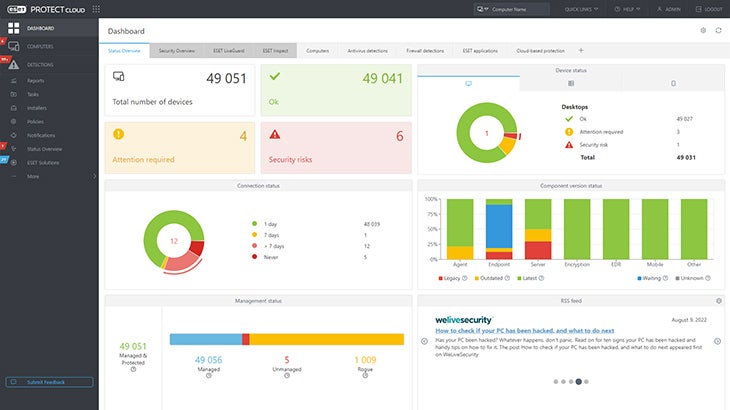
| Pros | Cons |
|---|---|
| Advanced role-based access control (RBAC) feature. | Lacks transparent pricing. |
| Botnet protection. | No SIEM. |
| Detects and neutralizes zero-day threats. | No built-in data loss prevention (DLP) feature. |
ESET doesn’t display pricing for their solutions. Contact their sales team for pricing information.

Best for DNS and email security
TitanHQ provides a comprehensive suite of cybersecurity solutions focusing on network security, particularly for email and web protection. Its products SpamTitan, WebTitan, SafeTitan, EncryptTitan, and ArcTitan collectively deliver an integrated solution.
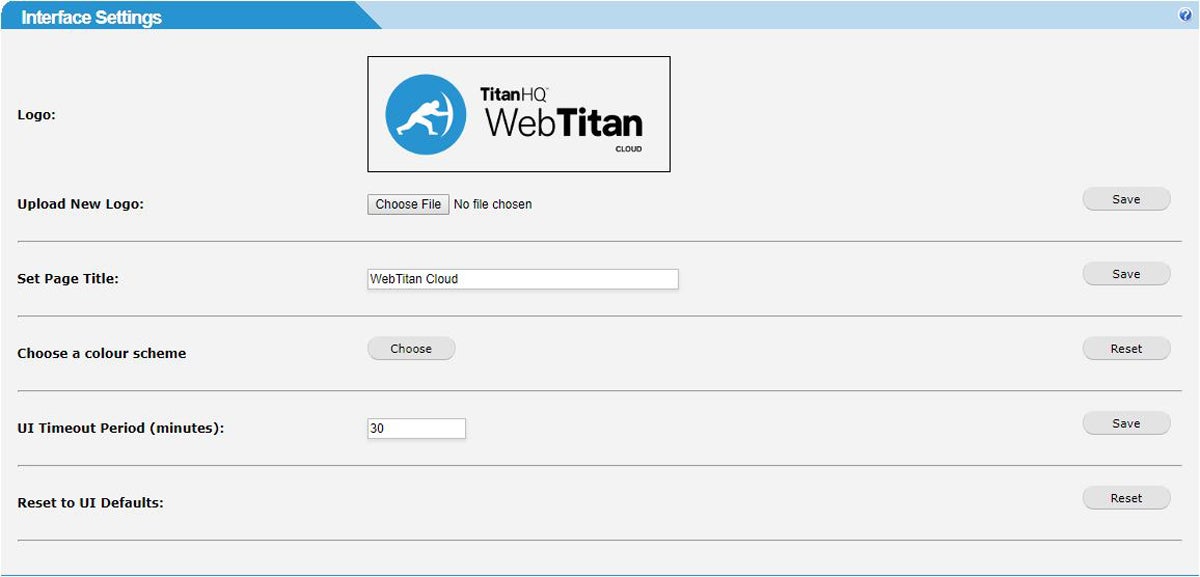
| Pros | Cons |
|---|---|
| Has advanced threat detection techniques like Bayesian auto learning and heuristics to defend against evolving threats. | Lacks transparent pricing. |
| Lightweight. | No dedicated vulnerability scanning and patch management features. |
| Uses AI-powered protection against active and emerging phishing URLs including zero-minute threats. | No built-in EDR or XDR. |
TitanHQ doesn’t directly list product pricing on its website but states that its pricing model is based on a per-user approach. They also offer monthly pricing options to cater to specific needs and budgets.
Get in touch with their sales team for full pricing details.
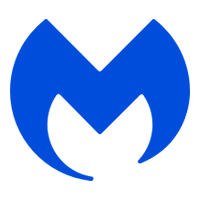
Best for malware detection and removal
Malwarebytes offers a single agent with simple management. It includes endpoint detection and response (EDR) which uses unique anomaly detection ML to detect both known and unknown threats across Windows, Mac, and Linux platforms. In addition, it offers managed detection and response (MDR) services that hunt down hidden threats based on suspicious activity and past IOCs, reducing dwell time and potential impact of hidden threats.
Furthermore, Malwarebytes provides DNS filtering that blocks access to known suspicious web domains and has in-depth virus scanning that finds threats other software misses.
The solution’s network isolation restricts device interactions, preventing unauthorized access from potential attackers and malware from establishing outbound connections. Malwarebytes also offers centralized management, flexible push-install options, and asset management to deploy solutions, track, manage, and monitor endpoints.
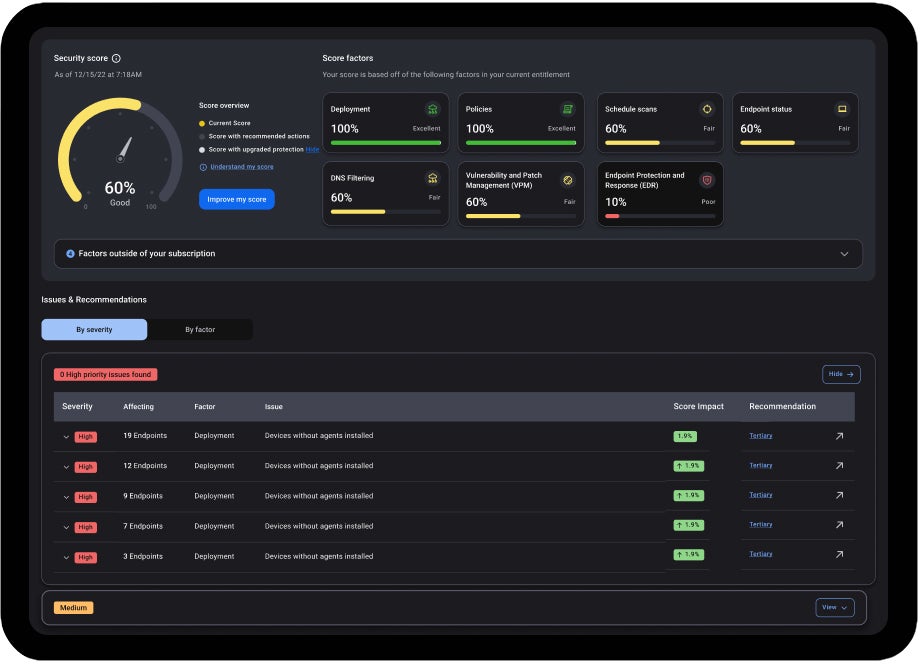
| Pros | Cons |
|---|---|
| Real-time protection. | Has conflicts with other antivirus software. |
| Simple and user-friendly interface. | No data breach protection. |
| Browser Guard feature blocks ads, scams, and trackers. | No built-in SIEM. |
| Uses unique anomaly detection machine learning to detect both known and unknown threats across different platforms. |
Malwarebytes offers for per-device pricing plans:
Plans start $69 per endpoint per year with a minimum of 3 devices. Reach out to the Malwarebytes sales department to know more.

Best for endpoint protection
Kaspersky network security solutions reduce exposure to cyberattacks through endpoint hardening and boost productivity with cloud-enabled controls. Its Endpoint Security for Business stands out with its special features that defend against fileless threats.
The platform streamlines security management with a unified console. Moreover, its agile protection technologies and multi-layered protection approach based on ML technology and threat intelligence ensure effective security. Kaspersky also offers straightforward migration from third-party endpoint protection, making the transition seamless.
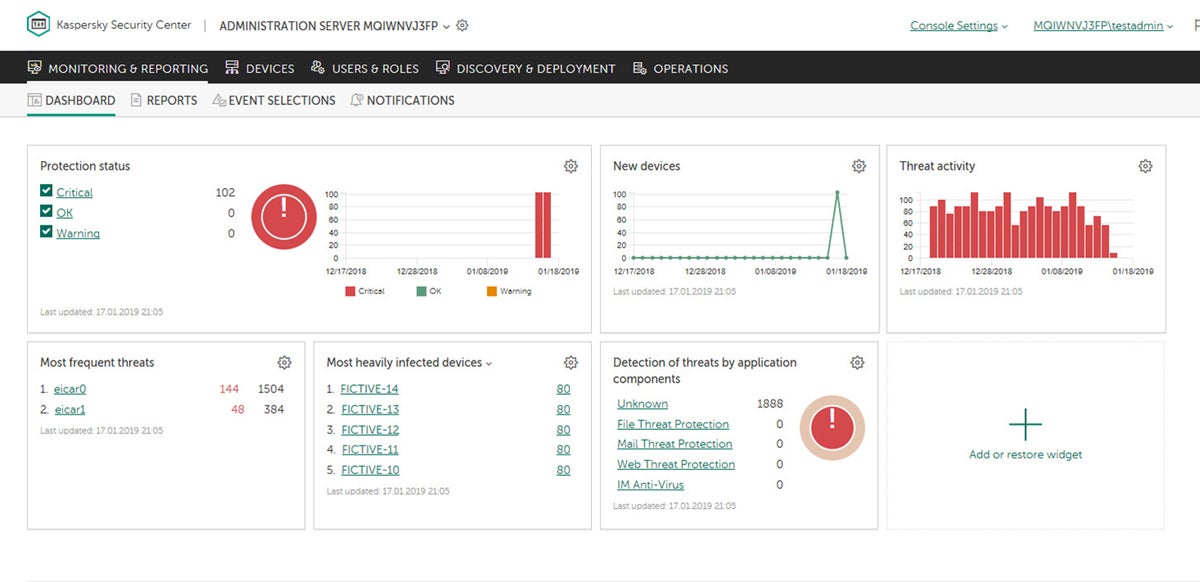
| Pros | Cons |
|---|---|
| Quick deployment on any platform or infrastructure. | Slows down network performance. |
| Real-time threat intelligence from 80 million global sensors. | Resource intensive. |
| VPN with wide OS support and extensive server locations. | Limited pricing details. |
| Robust password policies. | No built-in SIEM. |
Kaspersky has different pricing plans for SMBs and large enterprises.
SMB pricing starts at $202.50 (per year for 5 users).
Kaspersky doesn’t publish prices for enterprise plans — contact their sales department for more details.

Best for growing businesses
Avast Business optimizes network security by delivering all its services from the cloud. This approach reduces costs, such as WAN expenses, and eliminates the need to deal with network appliances.
The solution performs full inline inspection of SSL and internet traffic to all ports and protocols, updating global threat feeds in real time. It also includes device and policy management, centralized alerts and notifications, real-time commands, network discovery, and remote deployment.
Avast provides anti-malware and antivirus protection to keep devices and data safe against cyberattacks. It shields businesses against viruses, ransomware, spyware, zero-second threats, and Wi-Fi network vulnerabilities.
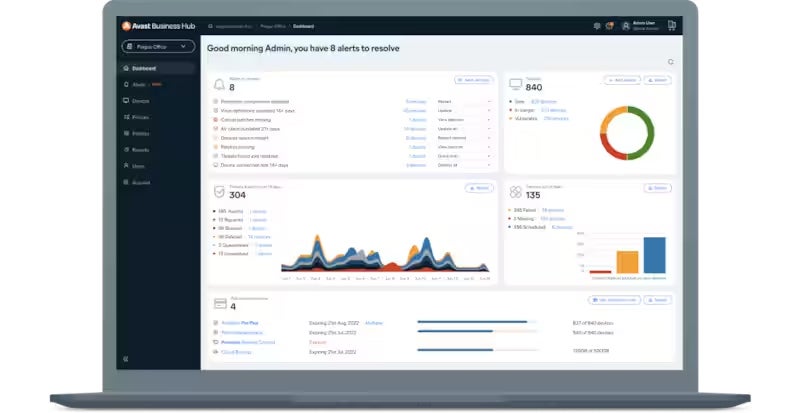
| Pros | Cons |
|---|---|
| Protects mail and web activity. | Time-consuming installation process. |
| Anti-spam feature. | Resource intensive. |
| Monitors threats network-wide across all connected endpoints. | Limited pricing details. |
| App behavior monitoring. | No built-in SIEM. |
Avast offers three pricing plans for small businesses:
These plans include up to 100 devices. For organizations with over 100 devices, contact the Avast Business sales team.

Best for ransomware defense
Sophos brings a range of network security tools to protect businesses from various cyberthreats. Its solutions include Sophos Firewall Security for network defense and Sophos Wireless for cloud-managed Wi-Fi. The platform also brings Zero Trust Network Access (ZTNA) for better segmentation, security, and visibility.
For businesses looking to automate their network security and management workflows, Sophos Central APIs are available. In addition, Sophos’ Extended Detection and Response (XDR) lets businesses identify and respond to threats across multiple security services.
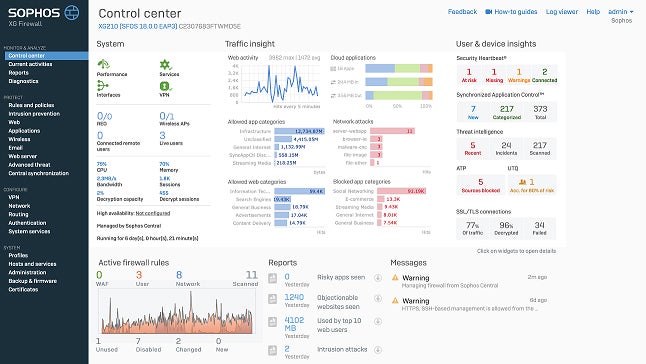
| Pros | Cons |
|---|---|
| Active adversary mitigations and ZTNA. | Doesn’t have SIEM. |
| Built-in anti-ransomware technology, deep learning, and exploit prevention. | Lacks pricing transparency. |
| Shared threat intelligence between endpoints and network. | Limited endpoint agent capabilities for macOS environments. |
Sophos doesn’t publish pricing details for any of its solutions. Reach out to their sales team for complete pricing details.
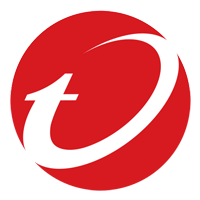
Best for threat detection and vulnerability intelligence
Trend Micro delivers solutions for effective protection for the entire IT environment, including users, devices, applications, and networks. These solutions come with a variety of features, like hardware for data-intensive data centers, virtual appliances for branch offices, and SaaS-based solutions that integrate seamlessly with AWS and Azure to streamline cloud operations. Additionally, they offer detection and response functionalities across multiple security layers.
What sets Trend Micro’s network security solutions apart is their adaptability. For instance, they offer secure access service edge (SASE) capabilities for real-time risk assessments of the connections between users, devices, and applications. This feature is particularly useful in minimizing risk and maintaining a secure network environment.
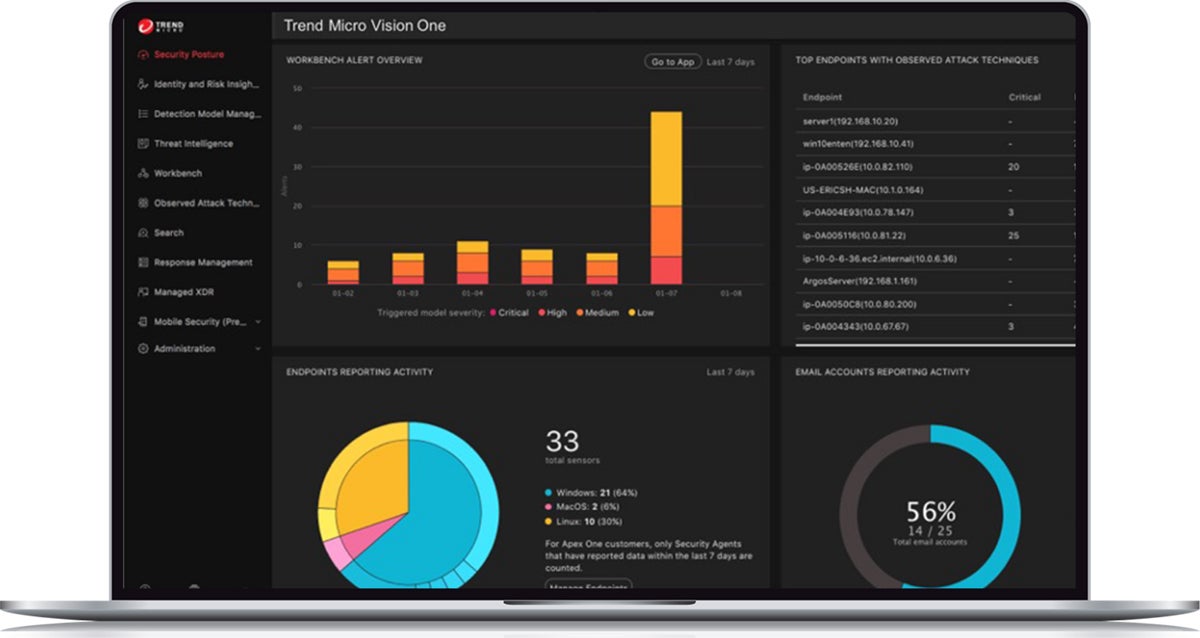
| Pros | Cons |
|---|---|
| Provides ransomware rollback features. | Significant number of false positives during testing. |
| Native SASE capabilities. | Lacks transparent pricing. |
| Deep Discovery Inspector feature offers 360 degrees of visibility by monitoring all network ports and over 105 different protocols. | No SIEM. |
| Runtime protection for virtual, physical, cloud, and container workloads. |
Trend Micro doesn’t give out pricing details on their website, though they do offer a handy (if highly complex) pricing calculator for estimates. For more information, you can get in touch with their sales team.

Best for managed service providers (MSPs)
SolarWinds has an extensive suite of network security tools to help businesses of all sizes protect their networks from threats. It excels in providing real-time visibility into network firewall security, monitoring firewall changes, and creating custom filters for specific firewall events. It also offers scheduled configuration backups and a configuration comparison tool, which are necessary for maintaining compliance and ensuring the availability of backups.
SolarWinds’ network performance monitoring and network configuration management capabilities help detect, diagnose, and resolve network performance issues. Additionally, its IP address management and switch port management features prevent IP conflicts and keep track of device connections, enhancing network security. SolarWinds is ideal for managed services providers (MSPs) wanting to provide scalable, reliable, and secure network management services.
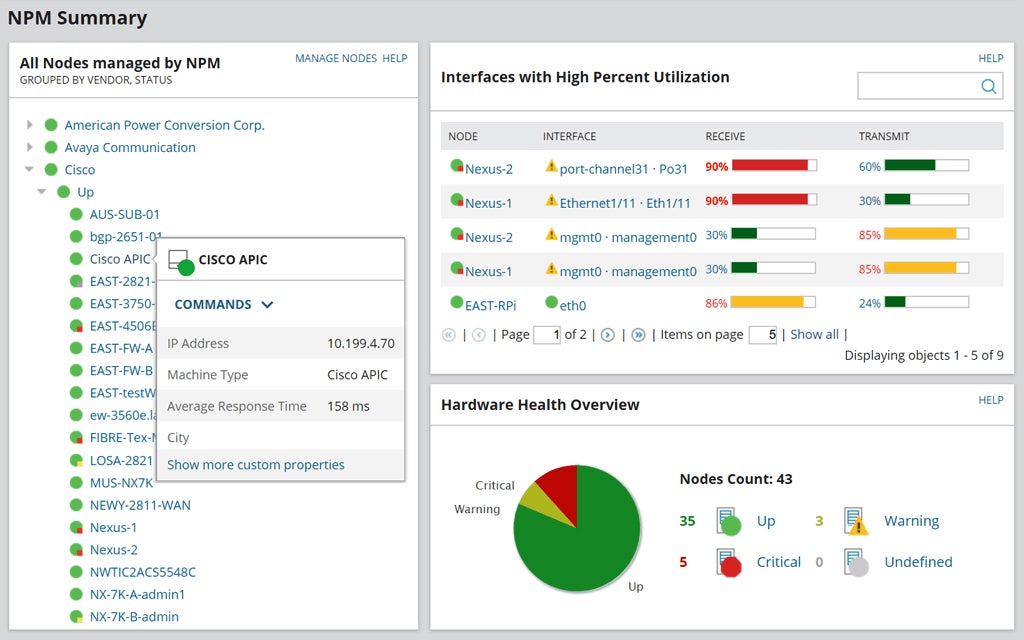
| Pros | Cons |
|---|---|
| Central IP address management. | Steep learning curve |
| Network configuration management that prevents network outages. | Upgrades are time-consuming. |
| Scheduled configuration backups. | Lacks transparent pricing. |
| Native SIEM feature. |
SolarWinds offers subscription and perpetual licensing but doesn’t display pricing information. Contact their sales team to find out more.
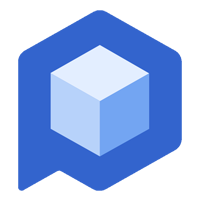
Best for cloud-based networks
Perimeter 81 offers cloud network security services that give unified access to remote servers, control access to infrastructure resources, and establish secure connections between the internet, private clouds, and public cloud providers. It combines network and application security capabilities within the cloud security model for complete coverage for both network and cloud applications.
This platform is built to meet the needs of businesses of all sizes, from small startups to large enterprises. One of its notable features is its ZTNA model, which makes sure that only authorized users can access network resources. Several advanced features complement this capability, including Firewall as a Service (FWaaS), Secure Web Gateway (SWG), and malware protection.
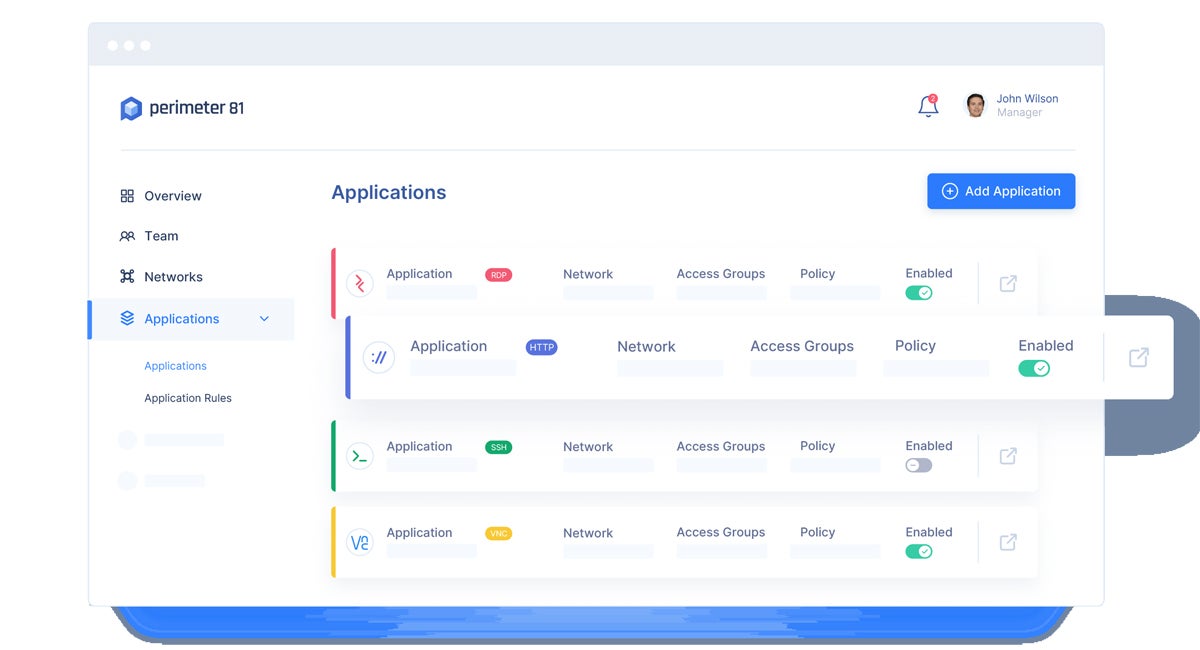
| Pros | Cons |
|---|---|
| Uses cutting-edge FWaaS. | No free trial. |
| HIPAA-compliant VPN. | No SIEM. |
| Built-in SASE. | No vulnerability scanning and patch management. |
| Bank-level encryption. |
Perimeter 81 offers multiple pricing plans:
There are several types of network security tools and technologies that form a comprehensive network security platform. These include firewalls, antivirus/anti-malware, network monitoring and visibility, identity and access management, encryption and data protection, web security, detection and response, vulnerability scanning and patch management, and SIEM. Having high performance and reliability is also an important feature of network security software.
Firewalls are a fundamental component of a network security software that control and track the flow of network traffic. They function as a barrier between trusted internal networks and untrusted external networks, and enforce predefined security rules to prevent unauthorized access and potential cyber threats.
Essentially, firewalls serve as the first line of defense, mitigating the risk of cyberattacks and securing the integrity of networked systems.
Antivirus and anti-malware guard against malicious software threats. They detect, quarantine, and remove various types of malware, including viruses, worms, Trojans, and spyware. By continuously scanning files, emails, and other data for known malware signatures and behavioral patterns, antivirus programs help stop the spread of infections and protect sensitive information.
Antivirus and anti-malware tools block harmful software that could compromise data confidentiality and disrupt network operations.
Network monitoring and visibility features give real-time insights into network activities. Monitoring detects anomalies and potential threats early, allowing rapid responses. Visibility offers in-depth understanding of network behavior, aiding in incident response, performance optimization, policy enforcement, and compliance management.
Together, monitoring and visibility contribute to a proactive security posture by swiftly uncovering and addressing security incidents and optimizing overall network performance.
Identity and access management (IAM) tools control and manage user access to network resources. These tools guarantee that only authorized individuals have appropriate access privileges, reducing the risk of unauthorized access, data breaches, and insider threats.
By providing centralized control over user identities, authentication, and authorization, IAM tools boost security and streamline user management.
Encryption and data protection play a pivotal role in the success of DLP within network security. Encryption safeguards the confidentiality and integrity of sensitive information, while DLP extends this defense by actively monitoring data, detecting policy violations, and preventing unauthorized access or data leaks.
Encryption, data protection, and DLP mechanisms create a strong defense against threats, ensuring a solid approach to safeguarding sensitive data.
Vulnerability scanning finds gaps in a network, allowing for proactive threat mitigation. Patch management, on the other hand, promotes prompt action against known vulnerabilities by applying patches and updates. These features help fortify the network against potential exploits, reduce the attack surface, and minimize the window of opportunity for cyber criminals to exploit vulnerabilities.
By aggregating and analyzing data from various sources, SIEM elevates the overall security posture by detecting and responding to potential threats in real-time, improving the resilience of the network against cyberthreats.
SIEM solutions facilitate centralized monitoring, analysis, and correlation of security events across the network and allows organizations to meet compliance requirements.
High performance and reliability are also critical features in a network security solution due to their impact on overall system efficacy. Minimal resource utilization makes sure that the software operates smoothly without significantly slowing down network speed. Reliability enables continuous and consistent security operations, decreasing downtime and potential security gaps.
To find the best network security software and tools for the year 2023, we systematically assessed different vendors. Our approach involved evaluating six key aspects of every software solution: cost, core features, performance and reliability, customer support, integrations, and ease of use.
We delved into the effectiveness of each software in meeting the standards set by these categories. We then assigned scores based on our evaluation and calculated the scores for each solution.
To evaluate the costs, we considered the pricing transparency and availability of free trials and their duration. We also checked if the provider offers multiple pricing models/options and gives businesses the opportunity to choose a plan that will suit their needs.
Criterion winner: BitDefender GravityZone
For the core features, we verified if the network security software has the following features as built in capabilities: firewall, intrusion detection and prevention, vulnerability scanning and patch management, identity and access management, network monitoring and visibility, antivirus and malware protection, encryption and data protection, web security, detection and response, and SIEM.
Criterion winners: Bitdefender GravityZone, Kaspersky, Sophos, and Trend Micro
To measure each vendor’s performance and reliability, we researched their resource consumption, scalability, and impact on network speed.
Criterion winners: ESET PROTECT Platform, Perimeter 81, and TitanHQ
We determined if each provider offers the following support options to their customers: live chat, phone, email, community, documentation.
We also factored in the availability of these options to all users regardless of payment tiers, their hours of availability, and the response times according to actual users.
Criterion winner: SolarWinds
For integrations, we examined the number of third-party solutions the solutions directly integrate with. We also considered the support for custom integrations.
Criterion winners: BitDefender GravityZone, Malwarebytes, Avast Business, Sophos, Trend Micro, ESET PROTECT Platform, SolarWinds, and Perimeter81
We looked into various user feedback to gauge the user-friendliness of the network security tools. We assessed whether each software was easy to install and manage for users of different levels of technical expertise.
Criterion winners: Kaspersky, Sophos, and ESET PROTECT Platform
No network can be considered completely secure because cybersecurity is dynamic and constantly evolving, with new threats and vulnerabilities emerging all the time. However, you can implement robust security measures to significantly reduce the risk of breaches.
Ultimately the best tool for defending your network is going to depend on the variety of factors that add up to your own unique use case. Networks are complex and multifaceted, and network security no less so.
That being said, based on our rigorous research, the security solutions best for the widest range of network defense use cases are tied between BitDefender GravityZone and ESET PROTECT Platform. Both tools provide a broad set of native features to protect nearly every aspect of your network and systems.
Yes, there are many free network tools and services available today, including the following:
| Free network security software | Description |
|---|---|
| FortifyData | Vulnerability assessment |
| OpenVAS | Vulnerability scanner |
| ShadowServer | Network reporting |
| Zscaler | Ransomware risk assessment |
| Cloudflare Unmetered DDoS Protection | Distributed Denial of Service (DDoS) protection |
For a more comprehensive list of free cybersecurity tools and services, check out recommendations from the Cybersecurity and Infrastructure Security Agency (CISA) page.
Choosing the right network security software can have a huge effect on the efficiency of your business operations. It’s not just about selecting the most advanced solution, but the one that best fits your specific needs and context.
Consider factors such as the size of your network, the nature of your data, and of course, your budget. Don’t hesitate to sign up for free trials to experience firsthand what the software can do for your organization. Look for solutions that offer a good balance between sophisticated features and usability.
The goal of network security is not to achieve complete security — which is impossible — but to manage and minimize risk to an acceptable level. It’s a continuous process that involves monitoring, improvement, and adaptation to new threats.
There is a broad selection of tools you can use to further strengthen your network security. Explore our article on types of network security solutions to implement to learn more.
Liz Laurente-Ticong is a tech specialist and multi-niche writer with a decade of experience covering software and technology topics and news. Her work has appeared in TechnologyAdvice.com as well as ghostwritten for a variety of international clients. When not writing, you can find Liz reading and watching historical and investigative documentaries. She is based in the Philippines.

Enterprise Networking Planet aims to educate and assist IT administrators in building strong network infrastructures for their enterprise companies. Enterprise Networking Planet contributors write about relevant and useful topics on the cutting edge of enterprise networking based on years of personal experience in the field.
Property of TechnologyAdvice. © 2025 TechnologyAdvice. All Rights Reserved
Advertiser Disclosure: Some of the products that appear on this site are from companies from which TechnologyAdvice receives compensation. This compensation may impact how and where products appear on this site including, for example, the order in which they appear. TechnologyAdvice does not include all companies or all types of products available in the marketplace.